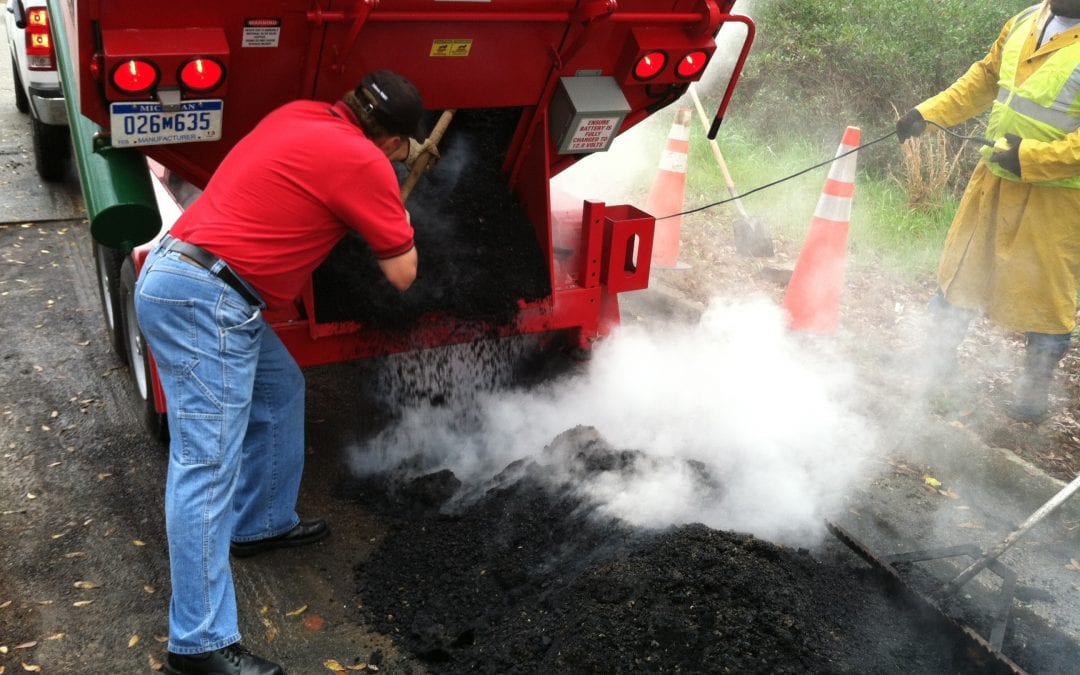In many regions of the country, pothole repairs cost millions of dollars annually. Making the right choice between hot and cold mix asphalt is essential to ensuring long-lasting repairs and reducing the economic burden for transportation agencies.
Read on to learn more about hot mix vs. cold mix asphalt and which solution is superior.
Cold Mix Asphalt
Despite its name, cold mix isn’t actually cold. While temperature ranges can vary between brands and mixes, they usually hover between 50°F to 100°F.
Due to fluctuating temperatures and cold weather conditions that make patch jobs very temporary, wintertime is not ideal for fixing potholes. However, repairs must still be made to ensure traffic safety and road integrity.
Cold mix asphalt works best when the temperature goes below 40°F. However, it still has a very short life expectancy and should only be used for temporary repairs until the weather warms up.
Proper patching techniques are required to ensure cold mix patches last as long as possible. Otherwise, the patch job will fail and result in wasted time and money. Studies estimate that 60% to 80% of the total patching cost is due to materials and labor.
Cold Mix Patching Procedure
Performing cold mix patching repairs is relatively straightforward. Workers use air compressors or brooms to clean out dirt, water, and debris. Once cleaned, the crew shovels cold mix into the hole.
Compaction methods can include using a compactor, shovel, or rolling a truck’s wheel over the cold patch spot. Sometimes, workers won’t compact the area—this is often the case when the repair is only meant to last for a very short period of time.
A good wintertime cold mix plus excellent craftsmanship and compaction levels will create a semi-permanent repair job that should last until the weather warms up.
Hot Mix Asphalt
Hot mix asphalt is superior to cold mix and works best when outside temperatures are above 40°F. Although it initially costs more than cold patching due to materials, equipment, and labor, the savings add up in the long run.
While each manufacturer has a slightly different formulation, most hot mix is made out of a combination of gravel, sand, and asphalt cement aggregate. The hot mix needs to be heated to over 400 degrees before workers can apply it to the pothole.
The combination of high-quality hot mix asphalt and great workmanship will result in a permanent patch that will prevent crews from returning to the same pothole a few months down the proverbial road—thereby saving a tremendous amount of money and time.
Hot Mix Patching Procedure
Once the hot mix has been sufficiently heated, workers apply it to the pothole. They then use a heavy compactor or steam roller to flush the patch with the rest of the surrounding asphalt.

Considering how labor and materials make up such a large portion of the total cost of an asphalt repair job, many municipalities and contractors are turning to hot boxes and asphalt recyclers to decrease costs and significantly improve productivity.
Falcon Hot Boxes & Recyclers
A Falcon hot box and recycler will save tremendous time and money while solving several problems associated with pothole repairs. Hot boxes keep the hot mix material at the optimal temperature throughout the day.
Work crews will only have to make one trip to the asphalt plant versus several if they use a truck bed to store the material. If it’s a multi-day patch job, the hot box can keep material warm overnight (for up to 72 hours), so it’s ready to go first thing in the morning.
Due to the lowered shoveling height of a Falcon hot box, workers won’t strain their arms, legs, or backs like they would shoveling material from the back of a dump truck. The ergonomics directly translates into increased productivity and fewer worker’s comp claims.
Finally, if you opt for the optional dual-burner system, you can recycle leftover asphalt chunks and millings. Falcon asphalt recyclers are engineered to preserve the original oils, which ensures soft and usable asphalt.
Falcon Hot Box and Recyclers
A Falcon hotbox is ideal for making hot mix asphalt repairs. You’ll save time and money while increasing worker efficiency. We offer a wide range of hot box machines that will meet or exceed the needs of your patching operation. Contact us below.


Recent Comments